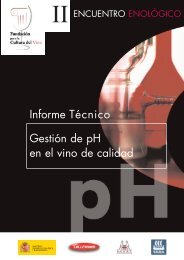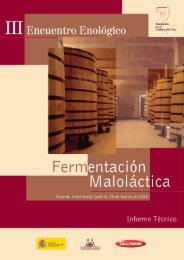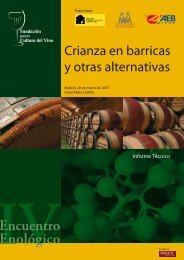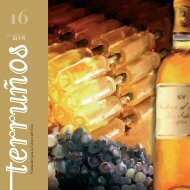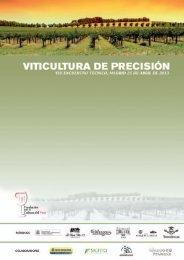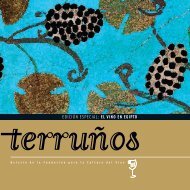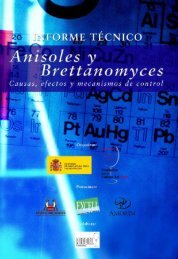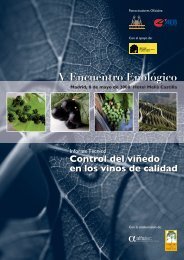Compuestos azufrados volátiles en vinos - Fundación para la ...
Compuestos azufrados volátiles en vinos - Fundación para la ...
Compuestos azufrados volátiles en vinos - Fundación para la ...
Create successful ePaper yourself
Turn your PDF publications into a flip-book with our unique Google optimized e-Paper software.
Nitrog<strong>en</strong> managem<strong>en</strong>t is critical for wine Managing Director, f<strong>la</strong>vour and styleEthanol is the major product of sugar ferm<strong>en</strong>tation.However, while DAP addition increases yeast growthand the rate of ferm<strong>en</strong>tation, it has little to no practicaleff ect on fi nal ethanol yield.Theoretically, DAP-grown yeast are forced to synthesiseamino acids for cell growth wh<strong>en</strong> compared withamino acid grown yeast. This decreases the proportionof sugar avai<strong>la</strong>ble for ethanol production (Alberset al. 1996), but in our experim<strong>en</strong>ts this has a minor affect on ethanol yield.Glycerol and acetic acid, which are important to winecomposition and fl avour, respond re<strong>la</strong>tively stronglyto juice YAN conc<strong>en</strong>tration (Albers et al. 1998; Torrea etal. 2005; Vi<strong>la</strong>nova et al. 2007).Figure 2 summarises g<strong>en</strong>eral tr<strong>en</strong>ds observed in syntheticjuice and white wine ferm<strong>en</strong>tations. Both glycero<strong>la</strong>nd acetic acid production dep<strong>en</strong>ds stronglyon the yeast strain used. For example, wh<strong>en</strong> usingyeast Vitilevure M05 DAP addition increases glycerolproduction whereas the reverse is the case for AWRI796 (Vi<strong>la</strong>nova et al. 2007). Both yeast, however, producethe lowest conc<strong>en</strong>trations of acetic acid at moderateYAN conc<strong>en</strong>trations (range of 200-250mg/L)while higher conc<strong>en</strong>trations are produced at bothlower and higher conc<strong>en</strong>trations of YAN. Malic acidconsumption does, however, increase with increasingDAP conc<strong>en</strong>tration, irrespective of yeast strain. On thecontrary and dep<strong>en</strong>ding on the strain, succinic acidconc<strong>en</strong>tration can increase with increasing DAP addition(Coulter et al. 2004). In g<strong>en</strong>eral, YAN can aff ect TAand the ba<strong>la</strong>nce of organic acids which can aff ect f<strong>la</strong>vour (Sowalsky and Noble 1998).Sulphur dioxide production during ferm<strong>en</strong>tation canalso be stimu<strong>la</strong>ted by initial YAN conc<strong>en</strong>tration, butthe response seems to be yeast strain dep<strong>en</strong>d<strong>en</strong>t.Experim<strong>en</strong>tal work in synthetic media and wort suggeststhat low SO2 is produced in low YAN mediabut increases wh<strong>en</strong> initial YAN avai<strong>la</strong>bility is higher(Duan et al. 2004; Osborne and Edwards 2006). SO 2production contrasts with H2S production, which isg<strong>en</strong>erally lowered by increasing YAN. Increased riskof MLF inhibition has also be<strong>en</strong> associated with highYAN addition but this inhibition has not be<strong>en</strong> conclusivelycorre<strong>la</strong>ted with SO 2production (Osborne andEdwards 2006). Nevertheless, until better informationis avai<strong>la</strong>ble, consideration should be giv<strong>en</strong> to limitinghigh YAN conditions wh<strong>en</strong> malo<strong>la</strong>ctic ferm<strong>en</strong>tation(MLF) is required.2.2 Vo<strong>la</strong>tile aroma compoundsAmong the various yeast metabolic pathways that areinfl u<strong>en</strong>ced by the nitrog<strong>en</strong> composition of the juice,those leading to vo<strong>la</strong>tile compounds are of particu<strong>la</strong>rimportance due to the primary role p<strong>la</strong>yed by ferm<strong>en</strong>tation-derivedvo<strong>la</strong>tiles in the aroma character of wine(Smyth et al. 2005). Several studies have indicated thatboth the total avai<strong>la</strong>ble nitrog<strong>en</strong> and the ba<strong>la</strong>nce ofamino acids and ammonia can signifi cantly aff ectthe production of differ<strong>en</strong>t groups of ferm<strong>en</strong>tationderivedvo<strong>la</strong>tile compounds.From a practical point of view, the problem of juice nitrog<strong>en</strong>composition is primarily linked to the frequ<strong>en</strong>toccurr<strong>en</strong>ce of juices with suboptimal conc<strong>en</strong>trationsof nitrog<strong>en</strong>, and higher risk of slow or stuck ferm<strong>en</strong>tation.As this problem is frequ<strong>en</strong>tly corrected in thewinery through the addition of DAP, several studieshave investigated the implications of this commonwinery practice on the vo<strong>la</strong>tile composition of wine(Ayrapaa 1971, Rapp and Versini 1991; Carrau 2003; Torreaand H<strong>en</strong>schke 2004; Hernandez-Orte et al. 2005,2006; Vi<strong>la</strong>nova et al. 2007). Due to the variety of yeaststrains and ferm<strong>en</strong>tation conditions employed, it issomewhat diffi cult to extrapo<strong>la</strong>te from the literaturedefi nitive conclusions concerning the eff ect of DAPaddition on wine aroma. Nevertheless, some g<strong>en</strong>eraltr<strong>en</strong>ds re<strong>la</strong>ting to DAP supplem<strong>en</strong>tation and wine vo<strong>la</strong>tilecomposition are summarised in Figure 3.Higher alcohols, which are directly re<strong>la</strong>ted to aminoacid metabolism in the cell, exhibit a characteristicbehaviour. Therefore, wh<strong>en</strong> total nitrog<strong>en</strong> is increasedby adding ammonium to a medium containing verylow levels of YAN, the production of higher alcoholsis initially increased, but th<strong>en</strong> t<strong>en</strong>ds to decrease aftera peak betwe<strong>en</strong> 200-300mg/L YAN. This activity dep<strong>en</strong>dson various factors, including yeast strain andferm<strong>en</strong>tation conditions.Higher alcohols are characterisedby fusel-like odours, and are g<strong>en</strong>erally thoughtto contribute to the complexity of wine ferm<strong>en</strong>tationbouquet. However, wh<strong>en</strong> pres<strong>en</strong>t in very highconc<strong>en</strong>trations they can have a negative impact onwine aroma, mainly because they mask fruity characters.Several authors have reported that ammoniumsupplem<strong>en</strong>tation can improve wine s<strong>en</strong>sory qualityConc<strong>en</strong>tration of yeast aroma compoundsHigher alcoholsEthyl acetateAcetate estersFatty acidsethyl estersBranched chainesters100 200 300 400 500YANFigure 3. Re<strong>la</strong>tionship betwe<strong>en</strong> initial YANconc<strong>en</strong>tration and fi nal conc<strong>en</strong>tration of vo<strong>la</strong>tilecompounds after ferm<strong>en</strong>tation.66



